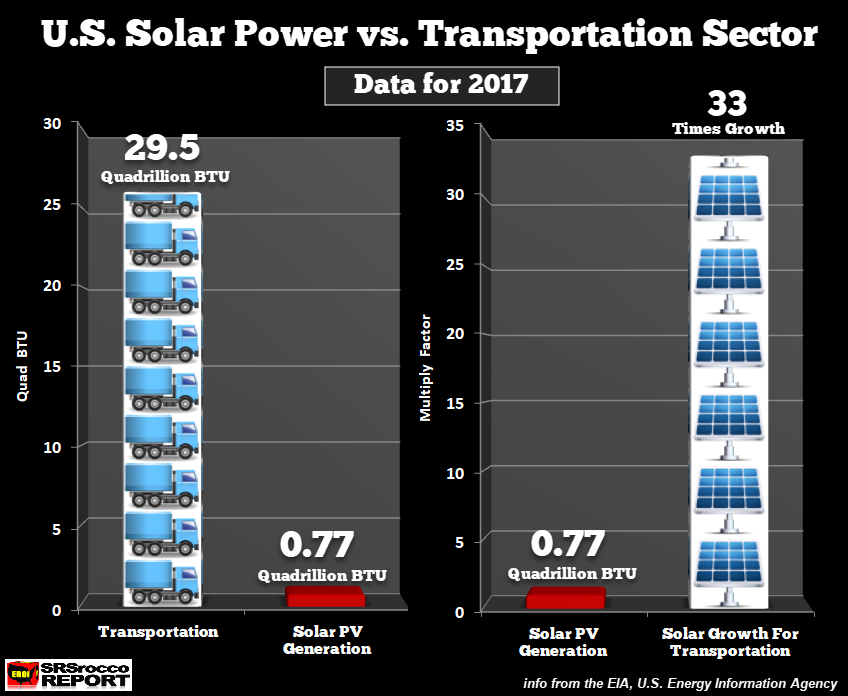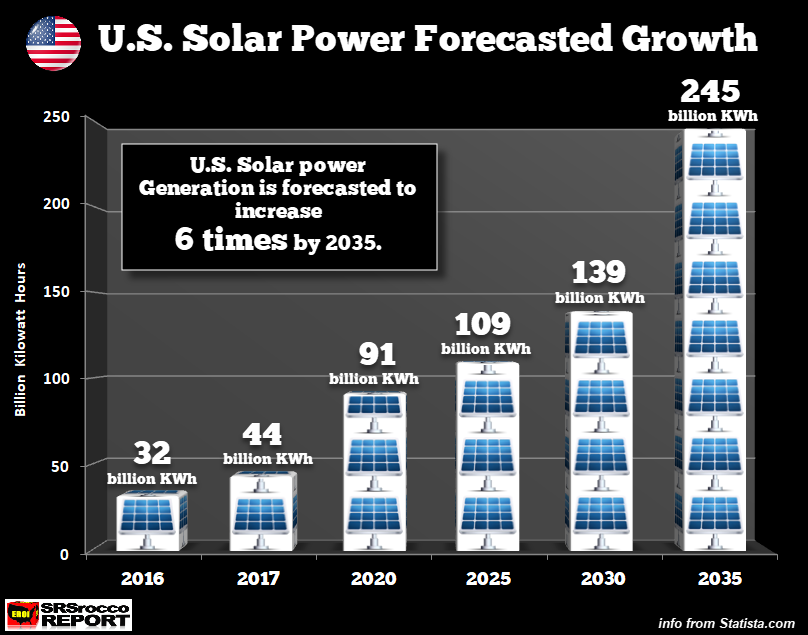The U.S. Solar PV Industry will never be able to grow large enough to power the transportation industry. Why? Because the amount of energy needed is well beyond the forecasted growth of U.S. solar power generation. And, it’s even worse than that. Industry analysts are making their forecasts based on rising fossil fuel production… the critical energy necessary to manufacture and build solar power plants.
There seems to be this notion by Americans, that in the future, they will just plug in their electric cars and drive to their heart’s desire. It seems as if no one takes the time to do a bit of simple math. While U.S. solar power generation has increased significantly over the past several years, it is still a fraction of the total energy supplied.
For example, U.S. fossil fuel production (coal, natural gas, and oil) still supplies 88 times more energy than solar PV power. However, if we just focus on the U.S. solar power generation versus the transportation sector, it only amounts to 2.6% of the total:

According to the EIA, the U.S. Energy Information Agency, total U.S. solar power generation in 2017 was 0.77 Quadrillion BTU’s versus 29.5 Quad BTU’s consumed by the entire domestic transportation sector… cars, buses, trucks, and trains. To give you an idea of how much 1 Quad BTU equals, it represents the energy in 170 million barrels of oil. Thus, the U.S. transportation sector consumes 29.5 times that amount or roughly 5 billion barrels of oil per year.
For the U.S. Solar Power Industry to increase in size to equal the same energy that is consumed by the transportation sector, it would need to grow by over 33 times. Now, I am just making some simple calculations here, but even with the optimistic projects in this renewable energy industry, solar would still only represent about 15% of the present transportation energy consumption by 2035:
The forecast for U.S. solar power generation growth is to increase from 44 billion kilowatt hours (kWh) in 2017 to 245 kWh by 2035:

So, if we multiply the present 0.77 Quad BTU’s of solar power generation (in the first chart) by six, it would equal roughly 4.6 Quad BTU’s by 2035. Thus, 4.6 Quad BTU’s versus the 29.5 Quad BTU’s consumed by the transportation sector would only be 15%.
Now, we must remember, not all of this solar power would be used to charge electric cars. The majority of future solar power generation would be used to supply electricity for residential, commercial and industrial sectors of the market.
I wanted to provide this information to show how inconceivable it is for the United States to be able to switch over to renewable energy such as solar to power our economy. For example, the U.S. consumed 78 Quadrillion BTU’s of fossil fuels (coal, natural gas, and oil) in 2017. Present solar power generation only represents 1% of this total.
I believe once U.S. shale oil production peaks and declines in the next few years, we will not have the necessary energy to ramp up solar power generation in the future. Americans better prepare for a much different world tomorrow. And NO, it will not be like the cartoon show, the Jetsons.
